Integration of Explainable Artificial Intelligence into Hybrid Long Short-Term Memory and Adaptive Kalman Filter for Sulfur Dioxide (SO2) Prediction in Kimberley, South Africa
Abstract
1. Introduction
2. Review of Literature
2.1. Long Short-Term Memory (LSTM)
2.2. Adaptive Kalman Filter
2.3. Explainable Artificial Intelligence (xAI)
3. Materials and Methods
3.1. Proposed Method
3.2. Model Integration Steps
3.2.1. Step 1: Raw Input Data
3.2.2. Step 2: Data Preprocessing
3.2.3. Step 3: LSTM Layer (Feature Extraction and Prediction)
3.2.4. Step 4: Adaptive Kalman Filter Layer (State Estimation and Correction)
- A.
- Prediction Step:
- B.
- Update Step:
3.2.5. Step 5: Explainable AI (xAI) Layer
3.2.6. Step 6: Model Evaluation
3.2.7. Step 7: Final Prediction/Output
3.3. Model Parameter Description
4. Results
4.1. Explainable AI: SHAP Analysis on AKF_LSTM_xAI Model
4.2. Explainable AI: LIME Analysis on AKF_LSTM_xAI Model
4.3. Models’ Prediction over Time
5. Discussion
6. Conclusions
Author Contributions
Funding
Institutional Review Board Statement
Informed Consent Statement
Data Availability Statement
Conflicts of Interest
Abbreviations
| ANN | Artificial Neural Network |
| SVM | Support vector machine |
| k-NN | k-nearest neighbor |
| CNN | Convolutional Neural Networks |
| LSTM | Long short-term memory |
| GRU | Gated recurrent unit |
| biGRU | bidirectional gated recurrent units |
| WRF-LETKF | Weather Research and Forecasting- Local Ensemble Transform Kalman Filter |
| CMAQ | Community Multiscale Air Quality |
| GAM | Generalized Additive Model |
| LRP | Layer-wise Relevance Propagation |
| LIME | Local Interpretable Model-Agnostic Explanations |
| TCN | Temporal Convolutional Network |
| SHAP | SHapley additive exPlanations |
| L2X | Learning to eXplain |
| RNNs | Recurrent Neural Networks |
| MAPE | Mean Absolute Percentage Error |
| SGRU | seasonal gated recurrent unit |
| MLP | Multilayer perceptron |
| AKF_LSTM_xAI | Adaptive Kalman Filter long short-term memory explainable artificial intelligence |
Appendix A
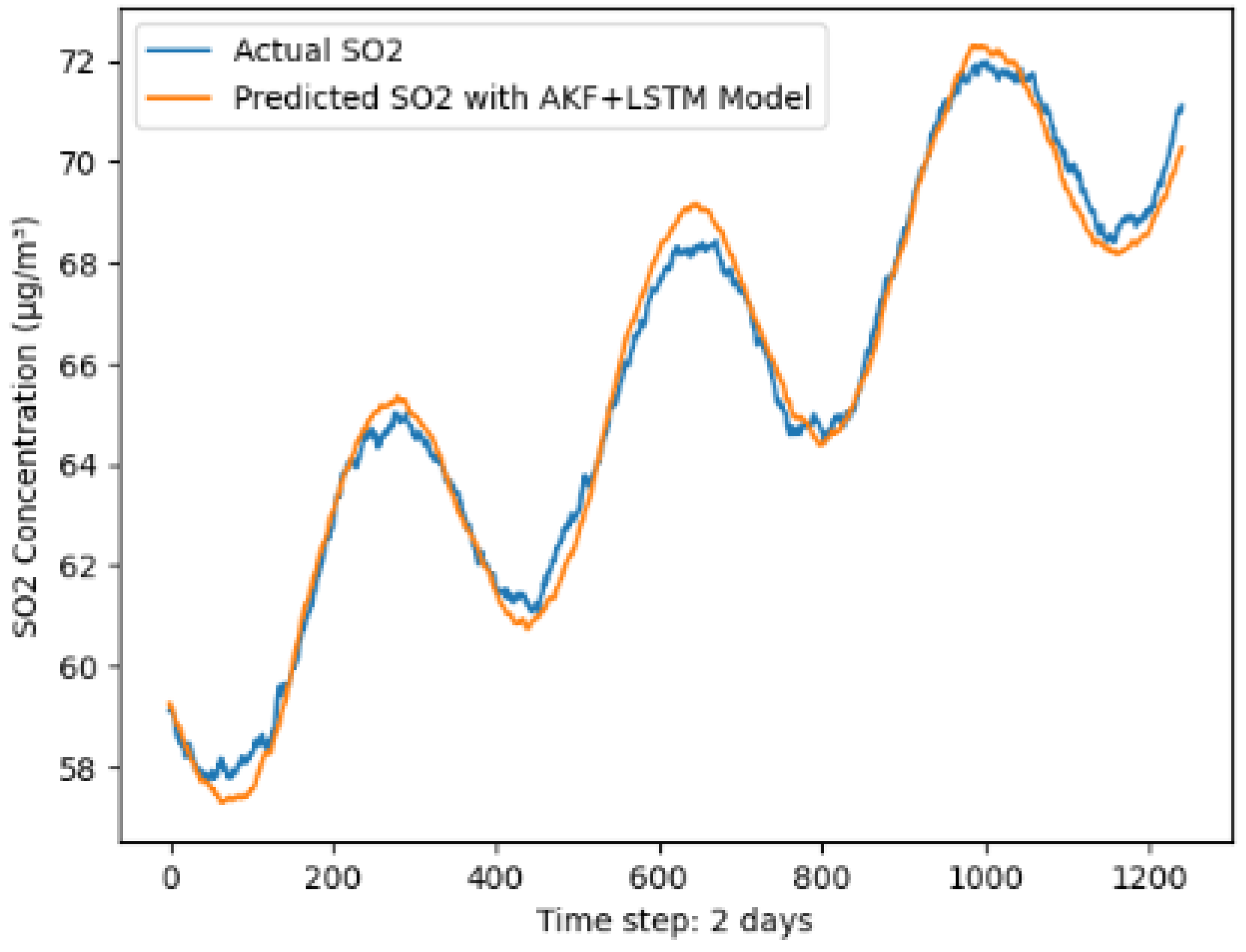
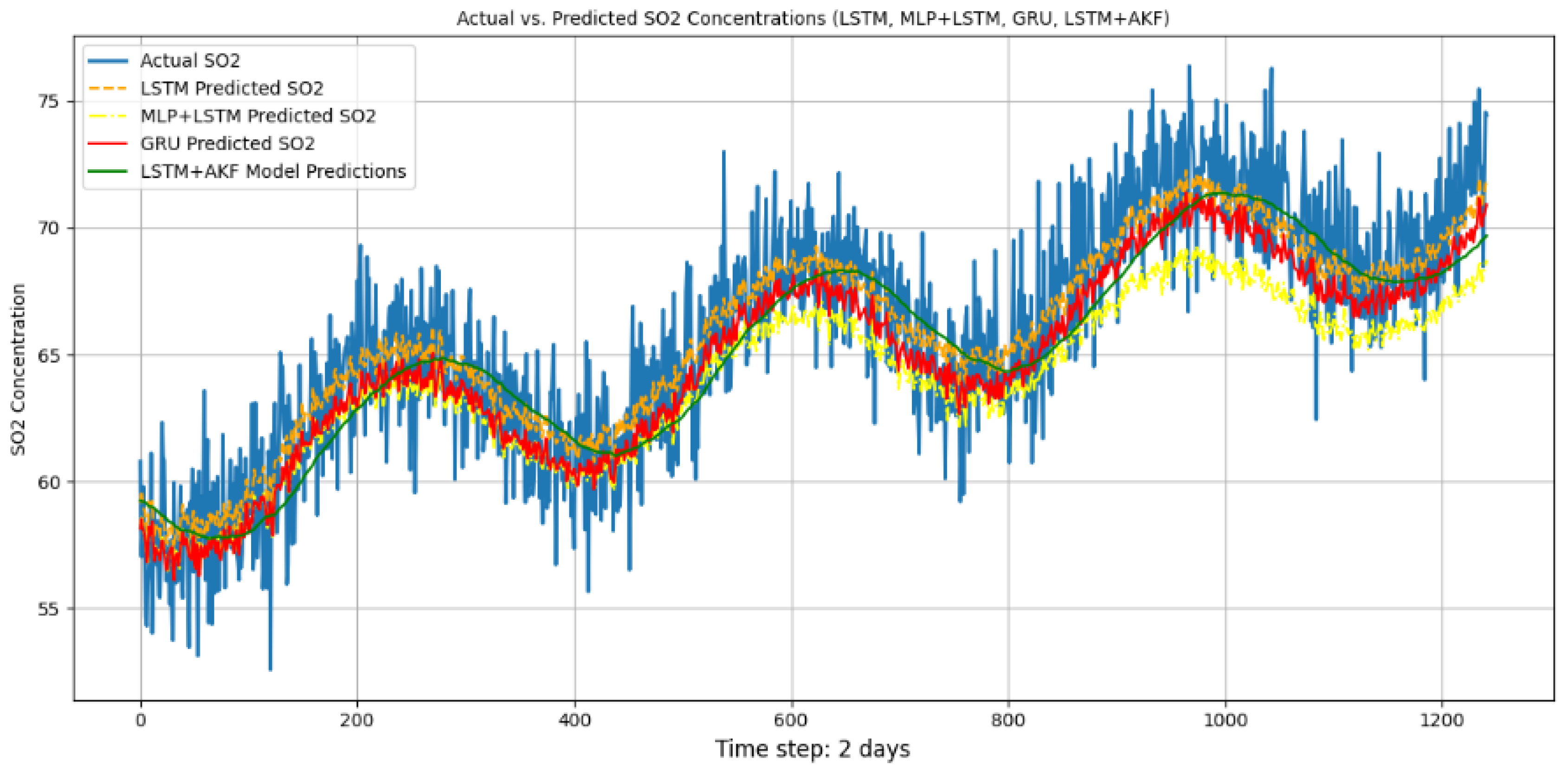
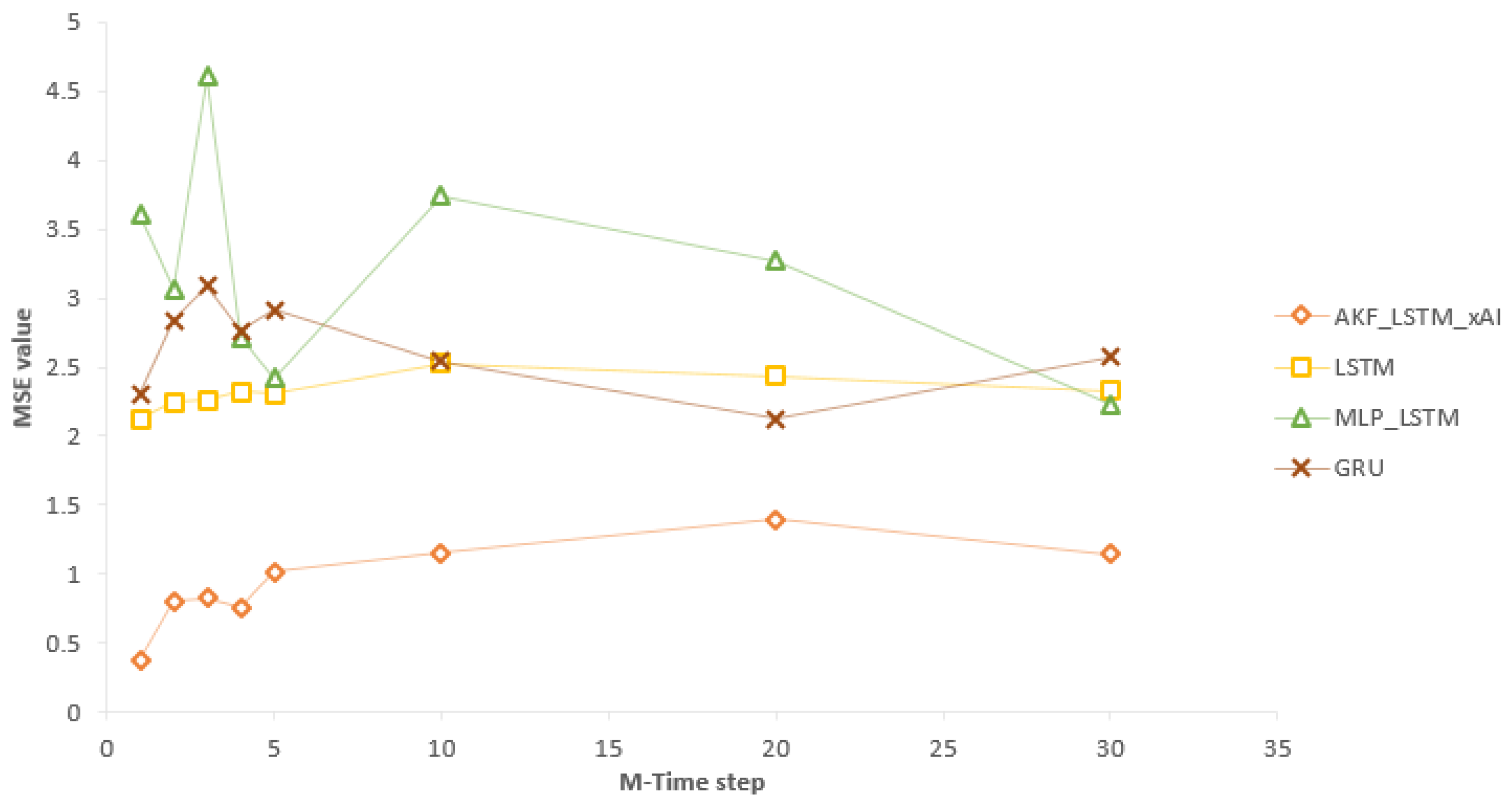
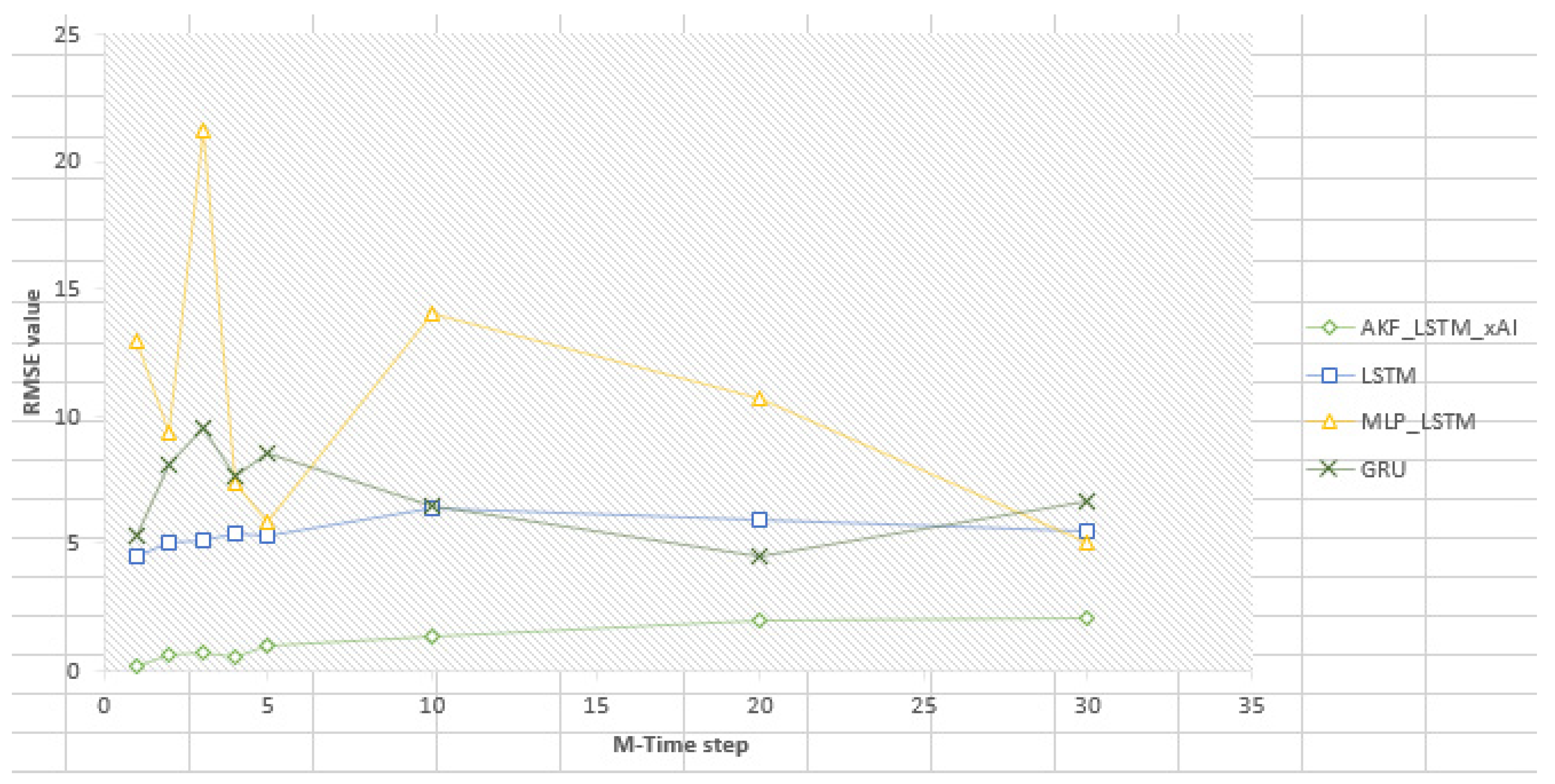
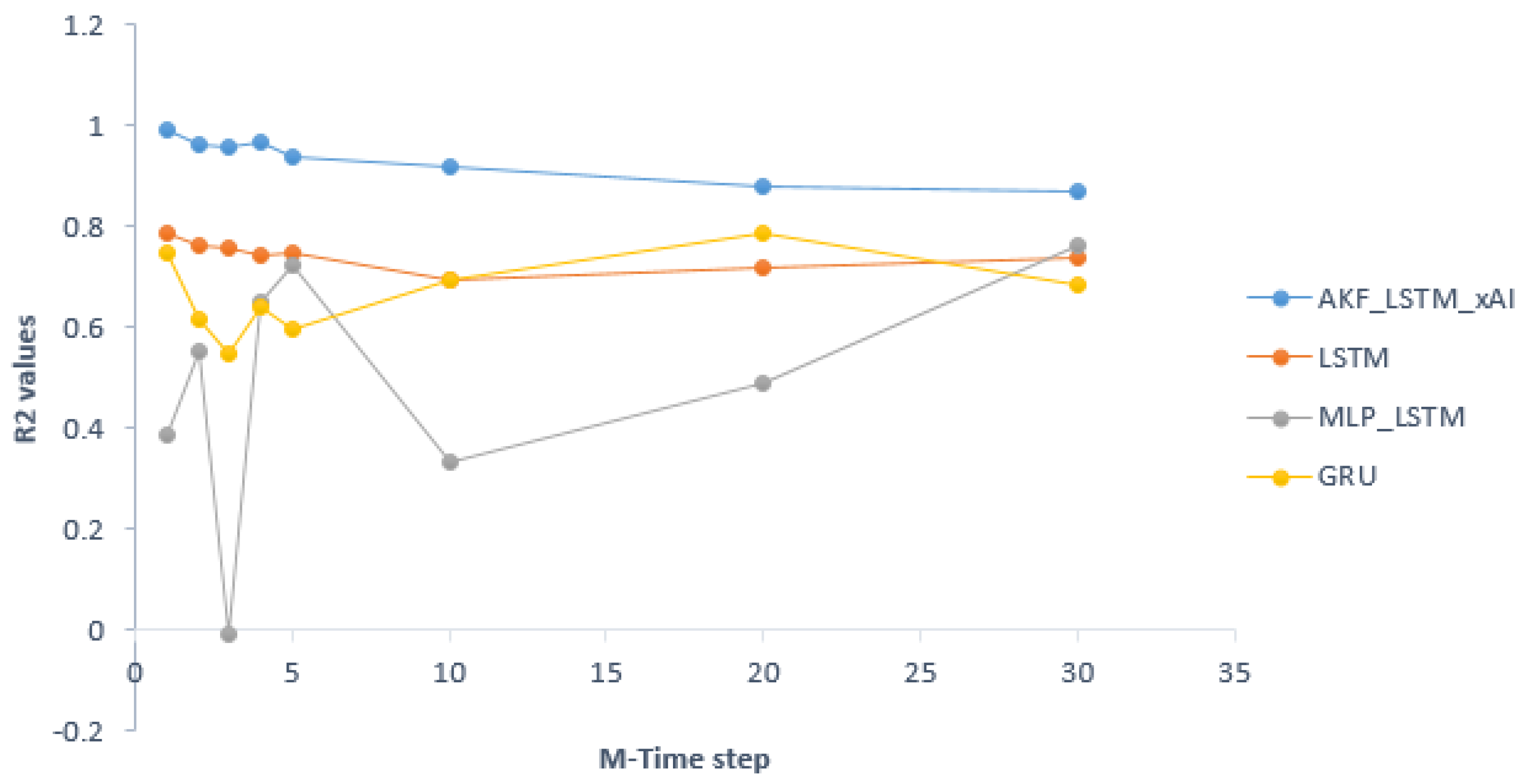
References
- World Health Organization. Air Pollution. 2021. Available online: https://www.who.int/news-room/fact-sheets/detail/ambient-(outdoor)-air-quality-and-health (accessed on 20 February 2025).
- Yeswanth, A.V.S.; Nandanwar, H.; Sharma, K.; Chauhan, A. A data-driven: Design, modeling analytics approach for smart IoT based air pollution monitoring system. In Proceedings of the 2023 2nd International Conference on Informatics, ICI 2023, Noida, India, 23–25 November 2023. [Google Scholar]
- Yeshe, D.; Wairooy, I.K.; Makalew, B.A. Predictive Analytics for Future Air Pollution Levels Based on Population Growth. In Procedia Computer Science; Elsevier: Amsterdam, The Netherlands, 2024. [Google Scholar]
- Oliva, P.; Alexianu, M.; Nasir, R. Suffocating Prosperity: Air Pollution and Economic Growth in Developing Countries; International Growth Centre: London, UK, 2019; pp. 1–9. [Google Scholar]
- Clark, R.; Reed, J.; Sunderland, T. Bridging funding gaps for climate and sustainable development: Pitfalls, progress and potential of private finance. Land Use Policy 2018, 71, 335–346. [Google Scholar] [CrossRef]
- Maisha, T.; Mulovhedzi, P.T.; Rambuwani, G.T.; Makgati, L.N.; Barnes, M.; Lekoloane, L.; Engelbrecht, F.A.; Ndarana, T.; Mbokodo, I.L.; Xulu, N.G.; et al. The Development of a Locally Based Weather and Climate Model in Southern Africa; Water Research Commission: Pretoria, South Africa, 2025; pp. 1–197. [Google Scholar]
- Department of Environmental Affairs. National Air Quality Indicator—Monthly Data Report for the Northern Cape Province; The South African Government’s Department of Environment, Forestry and Fisheries: Pretoria, South Africa, 2019; pp. 1–15. [Google Scholar]
- Becker, D.; Alfeus, A.; Molnár, P.; Boman, J.; Wichmann, J. Ambient PM2.5, soot, black carbon and organic carbon levels in Kimberley, South Africa. Clean Air J. 2024, 34, 2. [Google Scholar] [CrossRef]
- Charumbira, S.; Ncube, A. An Environmental Disaster: A Critical Review of Kimberlite Diamond Mining in Kimberley, South Africa. Int. J. Disaster Risk Reduct. 2022, 20. [Google Scholar] [CrossRef]
- Forestry Fisheries and the Environment, National Air Quality Indicator—Monthly Data Report for the Northern Cape Province; The Department of Forestry, Fisheries and the Environment: Pretoria, South Africa, 2024; pp. 1–15.
- Wang, T.; Zhang, Y.; Wang, F. Air quality prediction using machine learning methods: A review. In Environmental Modelling & Software; Elsevier: Amsterdam, The Netherlands, 2019; Volume 120, pp. 1–10. [Google Scholar]
- Alkhodaidi, A.; Attiah, A.; Mhawish, A.; Hakeem, A. The Role of Machine Learning in Enhancing Particulate Matter Estimation: A Systematic Literature Review. Technologies 2024, 12, 198. [Google Scholar] [CrossRef]
- Zhao, Z.; Qin, J.; He, Z.; Li, H.; Yang, Y.; Zhang, R. Combining forward with recurrent neural networks for hourly air quality prediction in Northwest of China. Environ. Sci. Pollut. Res. 2020, 27, 28931–28948. [Google Scholar] [CrossRef]
- AbdElkader, A.G.; ZainEldin, H.; Saafan, M.M. Optimizing wind power forecasting with RNN-LSTM models through grid search cross-validation. Sustain. Comput. Inform. Syst. 2025, 45, 101054. [Google Scholar] [CrossRef]
- Bhardwaj, D.; Ragiri, P.R. A Deep Learning Approach to Enhance Air Quality Prediction: Comparative Analysis of LSTM, LSTM with Attention Mechanism and BiLSTM. In Proceedings of the 2024 IEEE Region 10 Symposium, TENSYMP 2024, New Delhi, India, 27–29 September 2024. [Google Scholar]
- Agbehadji, I.E.; Obagbuwa, I.C. Systematic Review of Machine Learning and Deep Learning Techniques for Spatiotemporal Air Quality Prediction. Atmosphere 2024, 15, 1352. [Google Scholar] [CrossRef]
- Dalal, S.; Lilhore, U.K.; Faujdar, N.; Samiya, S.; Jaglan, V.; Alroobaea, R.; Shaheen, M.; Ahmad, F. Optimising air quality prediction in smart cities with hybrid particle swarm optimization-long-short term memory-recurrent neural network model. IET Smart Cities 2024, 6, 156–179. [Google Scholar] [CrossRef]
- Zhao, L.; Li, Z.; Qu, L. A novel machine learning-based artificial intelligence method for predicting the air pollution index PM2.5. J. Clean. Prod. 2024, 468, 143042. [Google Scholar] [CrossRef]
- Al-Eidi, S.; Amsaad, F.; Darwish, O.; Tashtoush, Y.; Alqahtani, A.; Niveshitha, N. Comparative Analysis Study for Air Quality Prediction in Smart Cities Using Regression Techniques. IEEE Access 2023, 11, 115140–115149. [Google Scholar] [CrossRef]
- Naresh, G.; Indira, B. Air Pollution Prediction using Multivariate LSTM Deep Learning Model. Int. J. Intell. Syst. Appl. Eng. 2024, 12, 211–220. [Google Scholar]
- Ahmad, E.; He, Y.; Luo, Z.; Lv, J. A Hybrid Long Short-Term Memory and Kalman Filter Model for Train Trajectory Prediction. IEEE Trans. Intell. Transp. Syst. 2024, 25, 7125–7139. [Google Scholar] [CrossRef]
- Li, Z.; Chen, L.; Zhang, Y. Air pollution prediction based on LSTM neural networks: A case study of PM2.5 in China. J. Environ. Manag. 2019, 245, 150–159. [Google Scholar]
- Tsai, Y.-T.; Zeng, Y.-R.; Chang, Y.-S. Air Pollution Forecasting Using RNN with LSTM. In Proceedings of the 2018 IEEE 16th Intl Conf on Dependable, Autonomic and Secure Computing, 16th Intl Conf on Pervasive Intelligence and Computing, 4th Intl Conf on Big Data Intelligence and Computing and Cyber Science and Technology Congress (DASC/PiCom/DataCom/CyberSciTech), Athens, Greece, 12–15 August 2018; pp. 1074–1079. [Google Scholar] [CrossRef]
- He, Z.; Guo, Q. Comparative Analysis of Multiple Deep Learning Models for Forecasting Monthly Ambient PM2.5. Concentrations: A Case Study in Dezhou City, China. Atmosphere 2024, 15, 1432. [Google Scholar] [CrossRef]
- Sun, Q.; Zhu, Y.; Chen, X.; Xu, A.; Peng, X. A hybrid deep learning model with multi-source data for PM2.5 concentration forecast. Air Qual. Atmos. Health 2021, 14, 503–513. [Google Scholar] [CrossRef]
- Gilik, A.; Ogrenci, S.; Özme, A. Air quality prediction using CNN+LSTM-based hybrid deep learning architecture. Environ. Sci. Pollut. Res. 2022, 29, 1–19. [Google Scholar] [CrossRef]
- Hu, M.; Lu, X.; Chen, Y.; Li, Z.; Wang, Y.; Fung, J.C. AirQFormer: Improving regional air quality forecast with a hybrid deep learning model. Sustain. Cities Soc. 2025, 119, 106133. [Google Scholar] [CrossRef]
- Sayeed, A.; Eslami, E.; Lops, Y.; Choi, Y. CMAQ-CNN: A new-generation of post-processing techniques for chemical transport models using deep neural networks. Atmos. Environ. 2022, 273, 118961. [Google Scholar] [CrossRef]
- Wang, L.; Chen, B.; Ouyang, J.; Mu, Y.; Zhen, L.; Yang, L.; Tang, L. Causal-inference machine learning reveals the drivers of China’s 2022 ozone rebound. Environ. Sci. Ecotechnol. 2025, 24, 100524. [Google Scholar] [CrossRef]
- Hong, H.; Choi, I.; Jeon, H.; Kim, Y.; Lee, J.B.; Park, C.H.; Kim, H.S. An Air Pollutants Prediction Method Integrating Numerical Models and Artificial Intelligence Models Targeting the Area around Busan Port in Korea. Atmosphere 2022, 13, 1462. [Google Scholar] [CrossRef]
- Karaiskos, P.; Munian, Y.; Martinez-Molina, A.; Alamaniotis, M. Indoor air quality prediction modeling for a naturally ventilated fitness building using RNN-LSTM artificial neural networks. Smart Sustain. Built Environ. 2024. [Google Scholar] [CrossRef]
- Zhang, B.; Zou, G.; Qin, D.; Lu, Y.; Jin, Y.; Wang, H. A novel Encoder-Decoder model based on read-first LSTM for air pollutant prediction. Sci. Total Environ. 2021, 765, 144507. [Google Scholar] [CrossRef] [PubMed]
- Aggarwal, A.; Toshniwal, D. A hybrid deep learning framework for urban air quality forecasting. J. Clean. Prod. 2021, 329, 129660. [Google Scholar] [CrossRef]
- Alazmi, A.; Rakha, H. Assessing and Validating the Ability of Machine Learning to Handle Unrefined Particle Air Pollution Mobile Monitoring Data Randomly, Spatially, and Spatiotemporally. Int. J. Environ. Res. Public Health 2022, 19, 10098. [Google Scholar] [CrossRef]
- Ali, S.; Alam, F.; Potgieter, J.; Arif, K.M. Leveraging Temporal Information to Improve Machine Learning-Based Calibration Techniques for Low-Cost Air Quality Sensors. Sensors 2024, 24, 2930. [Google Scholar] [CrossRef]
- Zhao, S.; Lin, H.; Wang, H.; Liu, G.; Wang, X.; Du, K.; Ren, G. Spatiotemporal distribution prediction for PM2.5 based on STXGBoost model and high-density monitoring sensors in Zhengzhou High Tech Zone, China. J. Environ. Manag. 2025, 373, 123682. [Google Scholar] [CrossRef]
- Wang, Y.Z.; He, H.D.; Huang, H.C.; Yang, J.M.; Peng, Z.R. High-resolution spatiotemporal prediction of PM2.5 concentration based on mobile monitoring and deep learning. Environ. Pollut. 2025, 364, 125342. [Google Scholar] [CrossRef]
- Marwala, T.; Fournier-Tombs, E.; Stinckwich, S. The Use of Synthetic Data to Train AI Models: Opportunities and Risks for Sustainable Development; United Nations University: Tokyo, Japan, 2023; pp. 1–5. [Google Scholar]
- Hua, V.; Nguyen, T.; Dao, M.S.; Nguyen, H.D.; Nguyen, B.T. The impact of data imputation on air quality prediction problem. PLoS ONE 2024, 12, 9. [Google Scholar] [CrossRef]
- Agbehadji, I.E.; Millham, R.C.; Fong, S.J.; Yang, H. Bioinspired computational approach to missing value estimation. Math. Probl. Eng. 2018, 2018, 9457821. [Google Scholar] [CrossRef]
- Teh, H.Y.; Kempa-Liehr, A.W.; Wang, K.I.-K. Sensor data quality: A systematic review. J. Big Data 2020, 7, 11. [Google Scholar] [CrossRef]
- Shi, T.; Li, P.; Yang, W.; Qi, A.; Qiao, J. Application of TCN-biGRU neural network in PM2.5 concentration prediction. Environ. Sci. Pollut. Res. Int. 2023, 30, 119506–119517. [Google Scholar] [CrossRef] [PubMed]
- Yuan, P.; Mei, Y.; Zhong, Y.; Xia, Y.; Fang, L. A Hybrid Deep Learning Model for Predicting PM2.5. In Proceedings of the 2022 7th International Conference on Intelligent Computing and Signal Processing, ICSP 2022, Wuhan, China, 22–25 April 2022. [Google Scholar]
- Faydi, M.; Zrelli, A.; Ezzedine, T. Smart Environment Monitoring Systems for PM2.5 Prediction Using Deep Learning Models in Smart City. In Proceedings of the 2023 International Symposium on Networks, Computers and Communications, ISNCC 2023, Doha, Qatar, 23–26 October 2023. [Google Scholar]
- Guo, Q.; He, Z.; Wang, Z. Monthly climate prediction using deep convolutional neural network and long short-term memory. Sci. Rep. 2024, 14, 17748. [Google Scholar] [CrossRef]
- Lin, Y.C.; Lin, Y.T.; Chen, C.R.; Lai, C.Y. Meteorological and traffic effects on air pollutants using Bayesian networks and deep learning. J. Environ. Sci. 2025, 152, 54–70. [Google Scholar] [CrossRef]
- Kaveh, M.; Mesgari, M.S.; Kaveh, M. A Novel Evolutionary Deep Learning Approach for PM2.5 Prediction Using Remote Sensing and Spatial–Temporal Data: A Case Study of Tehran. ISPRS Int. J. Geo-Inf. 2025, 14, 42. [Google Scholar] [CrossRef]
- Wang, H.S.; Jwo, D.J.; Gao, Z.H. Towards Explainable Artificial Intelligence for GNSS Multipath LSTM Training Models. Sensors 2025, 25, 978. [Google Scholar] [CrossRef] [PubMed]
- Ganguli, I.; Nakum, M.; Das, B.; Kshetrimayum, N. Comprehensive Analysis of Air Quality Trends in India Using Machine Learning and Deep Learning Models. In Proceedings of the ICDCN 2025 the 26th International Conference on Distributed Computing and Networking, Hyderabad, India, 4–7 January 2025. [Google Scholar]
- Beriwal, S.; Ayeelyan, J. Decoding Pollution: A Federated Learning-Based Pollution Prediction Study with Health Ramifications Using Causal Inferences. Electronics 2025, 14, 350. [Google Scholar] [CrossRef]
- Agbehadji, I.E.; Obagbuwa, I.C. Mode Decomposition Bi-Directional Long Short-Term Memory (BiLSTM) Attention Mechanism and Transformer (AMT) Model for Ozone (O3) Prediction in Johannesburg, South Africa. Forecast. 2025, 7, 15. [Google Scholar] [CrossRef]
- Niu, M.; Zhang, Y.; Ren, Z. Deep Learning-Based PM2.5 Long Time-Series Prediction by Fusing Multisource Data—A Case Study of Beijing. Atmosphere 2023, 14, 340. [Google Scholar] [CrossRef]
- Ran, X.; Shan, Z.; Fang, Y.; Lin, C. An LSTM-Based Method with Attention Mechanism for Travel Time Prediction. Sensor 2019, 19, 861. [Google Scholar] [CrossRef]
- Wang, Z.; Xu, C.; Tan, Y.P.; Yuan, J. Attention-Aware Noisy Label Learning for Image Classification. In Computer Vision and Pattern Recognition; Elsevier: Amsterdam, The Netherlands, 2020; pp. 1–10. [Google Scholar] [CrossRef]
- Chen, H.; Yang, J.; Fu, X.; Zheng, Q.; Song, X.; Fu, Z.; Wang, J.; Liang, Y.; Yin, H.; Liu, Z.; et al. Water Quality Prediction Based on LSTM and Attention Mechanism: A Case Study of the Burnett River, Australia. Sustainability 2022, 14, 13231. [Google Scholar] [CrossRef]
- Pantiskas, L.; Verstoep, K.; Bal, H. Interpretable Multivariate Time Series Forecasting with Temporal Attention Convolutional Neural Networks. In Proceedings of the IEEE Symposium Series on Computational Intelligence (SSCI), Canberra, Australia, 1–4 December 2020. [Google Scholar]
- Ahmad, R.; Alkhammash, E.H. Online Adaptive Kalman Filtering for Real-Time Anomaly Detection in Wireless Sensor Networks. Sensor 2024, 24, 5046. [Google Scholar] [CrossRef] [PubMed]
- Singh, R.; Mehra, R.; Sharma, L. Design of Kalman Filter for Wireless Sensor Network. In Proceedings of the 2016 International Conference on Internet of Things and Applications (IOTA), Pune, India, 22–24 January 2016; IEEE: New York, NY, USA, 2016. [Google Scholar]
- Zhou, H.; Wang, T.; Zhao, H.; Wang, Z. Updated Prediction of Air Quality Based on Kalman-Attention-LSTM Network. Sustainability 2023, 15, 356. [Google Scholar] [CrossRef]
- Christakis, I.; Tsakiridis, O.; Kandris, D.; Stavrakas, I. A Kalman Filter Scheme for the Optimization of Low-Cost Gas Sensor Measurements. Electronics 2024, 13, 25. [Google Scholar] [CrossRef]
- Song, X.; Huang, J.; Song, D. Air quality prediction based on LSTM-kalman model. In Proceedings of the 2019 IEEE 8th Joint International Information Technology and Artificial Intelligence Conference (ITAIC 2019), Chongqing, China, 24–26 May 2019; pp. 1–5. [Google Scholar]
- Yang, C.H.; Chen, P.H.; Wu, C.H.; Yang, C.S.; Chuang, L.Y. Deep learning-based air pollution analysis on carbon monoxide in Taiwan. Ecol. Inform. 2024, 80, 102477. [Google Scholar] [CrossRef]
- Kataria, A.; Puri, V. AI- and IoT-based hybrid model for air quality prediction in a smart city with network assistance. IET Netw. 2022, 11, 221–233. [Google Scholar] [CrossRef]
- Yang, S.C.; Cheng, F.Y.; Wang, L.J.; Wang, S.H.; Hsu, C. Impact of lidar data assimilation on planetary boundary layer wind and PM2.5 prediction in Taiwan. Atmos. Environ. 2022, 277, 119064. [Google Scholar] [CrossRef]
- Lee, K.; Yu, J.; Lee, S.; Park, M.; Hong, H.; Park, S.Y.; Choi, M.; Kim, J.; Kim, Y.; Woo, J.-H.; et al. Development of Korean Air Quality Prediction System version 1 (KAQPS v1) with focuses on practical issues. Geosci. Model Dev. 2020, 13, 1055–1073. [Google Scholar] [CrossRef]
- Kong, L.; Tang, X.; Zhu, J.; Wang, Z.; Pan, Y.; Wu, H.; Wu, L.; Wu, Q.; He, Y.; Tian, S. Improved Inversion of Monthly Ammonia Emissions in China Based on the Chinese Ammonia Monitoring Network and Ensemble Kalman Filter. Environ. Sci. Technol. 2019, 53, 12529–12538. [Google Scholar] [CrossRef]
- Kong, L.; Tang, X.; Zhu, J.; Wang, Z.; Li, J.; Wu, H.; Wu, Q.; Chen, H.; Zhu, L.; Wang, W.; et al. A 6-year-long (2013-2018) high-resolution air quality reanalysis dataset in China based on the assimilation of surface observations from CNEMC. Earth Syst. Sci. Data 2021, 13, 529–570. [Google Scholar] [CrossRef]
- Kong, L.; Tang, X.; Wang, Z.; Zhu, J.; Li, J.; Wu, H.; Wu, Q.; Chen, H.; Zhu, L.; Wang, W.; et al. Changes in air pollutant emissions in China during two clean-air action periods derived from the newly developed Inversed Emission Inventory for Chinese Air Quality (CAQIEI). Earth Syst. Sci. Data 2024, 16, 4351–4387. [Google Scholar] [CrossRef]
- Minh, D.; Wang, H.X.; Li, Y.F.; Nguyen, T.N. Explainable artificial intelligence: A comprehensive review. Artif. Intell. Rev. 2022, 55, 3503–3568. [Google Scholar] [CrossRef]
- Abdollahi, A.; Pradhan, B. Explainable artificial intelligence (XAI) for interpreting the contributing factors feed into the wildfire susceptibility prediction model. Sci. Total Environ. 2023, 879, 163004. [Google Scholar] [CrossRef] [PubMed]
- Zafar, M.R.; Khan, N. Deterministic Local Interpretable Model-Agnostic Explanations for Stable Explainability. Mach. Learn. Knowl. Extr. 2021, 3, 525–541. [Google Scholar] [CrossRef]
- Dillon, E.; Lundberg, S.; LaRiviere, J.; Roth, J.; Syrgkanis, V. Be careful when interpreting predictive models in search of causal insights. In A Joint Article About Causality and Interpretable Machine Learning with 2018; Judea Pearl: Los Angeles, CA, USA, 2018; Available online: https://shap.readthedocs.io/en/latest/example_notebooks/overviews/Be%20careful%20when%20interpreting%20predictive%20models%20in%20search%20of%20causal%20insights.html (accessed on 17 April 2025).
- Li, Z.; Guo, X.; Qiang, S. A survey of deep causal models and their industrial applications. Artif. Intell. Rev. 2024, 57, 298. [Google Scholar] [CrossRef]
- Lagemann, K.; Lagemann, C.; Taschler, B.; Mukherjee, S. Deep learning of causal structures in high dimensions under data limitations. Nat. Mach. Intell. 2023, 5, 1306–1316. [Google Scholar] [CrossRef]
- Zhao, C.; Lin, Z.; Yang, L.; Jiang, M.; Qiu, Z.; Wang, S.; Gu, Y.; Ye, W.; Pan, Y.; Zhang, Y.; et al. A study on the impact of meteorological and emission factors on PM2.5 concentrations based on machine learning. J. Environ. Manag. 2025, 376, 124347. [Google Scholar] [CrossRef]
- Zhong, J.; Xiao, R.; Wang, P.; Yang, X.; Lu, Z.; Zheng, J.; Jiang, H.; Rao, X.; Luo, S.; Huang, F. Identifying influence factors and thresholds of the next day’s pollen concentration in different seasons using interpretable machine learning. Sci. Total Environ. 2024, 935, 173430. [Google Scholar] [CrossRef]
- Zhang, Y.; Sun, Q.; Liu, J.; Petrosian, O. Long-Term Forecasting of Air Pollution Particulate Matter (PM2.5) and Analysis of Influencing Factors. Sustainability 2024, 16, 19. [Google Scholar] [CrossRef]
- Zhang, L.; Wang, L.; Ji, D.; Xia, Z.; Nan, P.; Zhang, J.; Li, K.; Qi, B.; DU, R.; Sun, Y.; et al. Explainable ensemble machine learning revealing the effect of meteorology and sources on ozone formation in megacity Hangzhou, China. Sci. Total Environ. 2024, 922, 171295. [Google Scholar] [CrossRef]
- Zhang, C.; Xie, Y.; Shao, M.; Wang, Q.G. Application of machine learning to analyze ozone sensitivity to influencing factors: A case study in Nanjing, China. Sci. Total Environ. 2024, 929, 172544. [Google Scholar] [CrossRef]
- Oliveira, P.; Franco, F.; Bessa, A.; Durães, D.; Novais, P. Employing Explainable AI Techniques for Air Pollution: An Ante-Hoc and Post-Hoc Approach in Dioxide Nitrogen Forecasting. In Lecture Notes in Computer Science (Including Subseries Lecture Notes in Artificial Intelligence and Lecture Notes in Bioinformatics); Springer: Cham, Switzerland, 2025. [Google Scholar]
- Tan, J.C.M.; Cao, Q.; Quek, C. FE-RNN: A fuzzy embedded recurrent neural network for improving interpretability of underlying neural network. Inf. Sci. 2024, 663, 120276. [Google Scholar]
- Talaat, F.M. Explainable Enhanced Recurrent Neural Network for lie detection using voice stress analysis. Multimed Tools Appl. 2024, 83, 32277–32299. [Google Scholar] [CrossRef]
- Kiran, A.; Kumar, H.; Sivanandam, S.; Senthilvel, P.G.; Lalitha, R.V.S.; Reddy, C.P. Explainable AI in thermal modelling enhancing precision in thermal gradient monitoring for additive manufacturing using LSTM networks. Therm. Sci. Eng. Prog. 2025, 60, 103465. [Google Scholar] [CrossRef]
- Ndao, M.L.; Youness, G.; Niang, N.; Saporta, G. Improving predictive maintenance: Evaluating the impact of preprocessing and model complexity on the effectiveness of eXplainable Artificial Intelligence methods. Eng. Appl. Artif. Intell. 2025, 144, 110144. [Google Scholar] [CrossRef]
- Sunu Fathima, T.H.; Kovoor, B.C. Explainable AI Insights into a Time Series Weather Prediction Model Using Stacked LSTM. In Lecture Notes in Networks and Systems; Springer International Publishing AG: Cham, Switzerland, 2025. [Google Scholar]
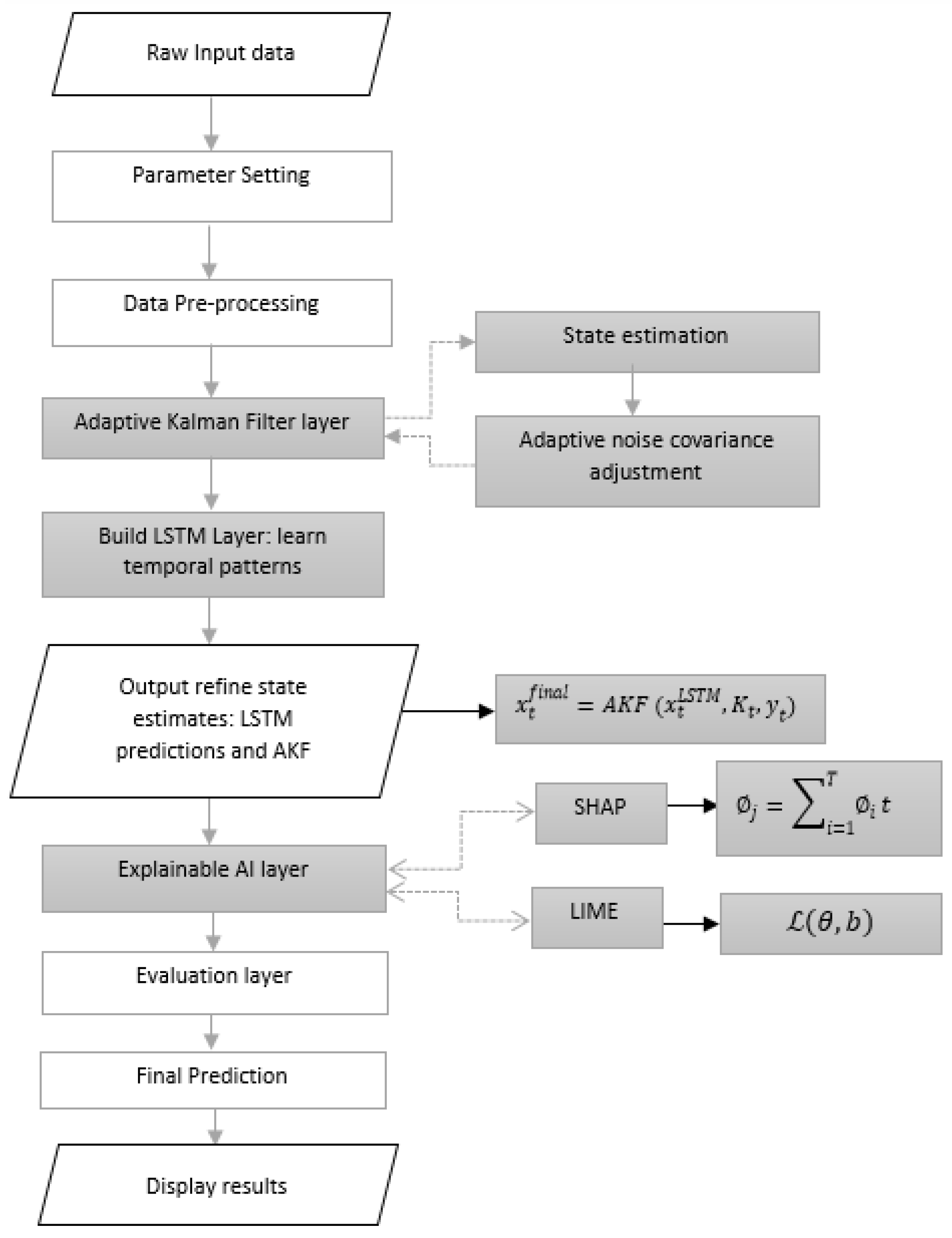
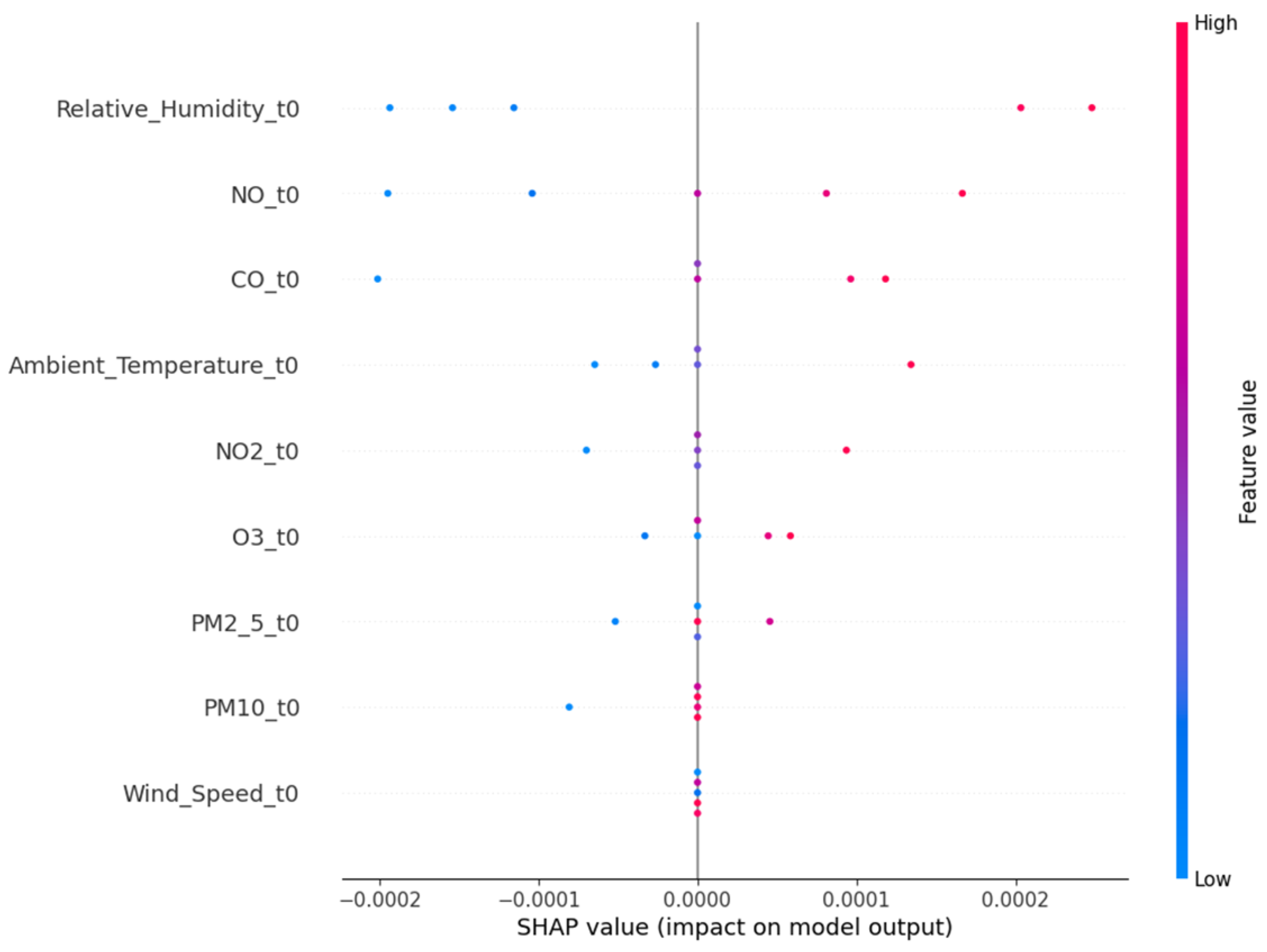
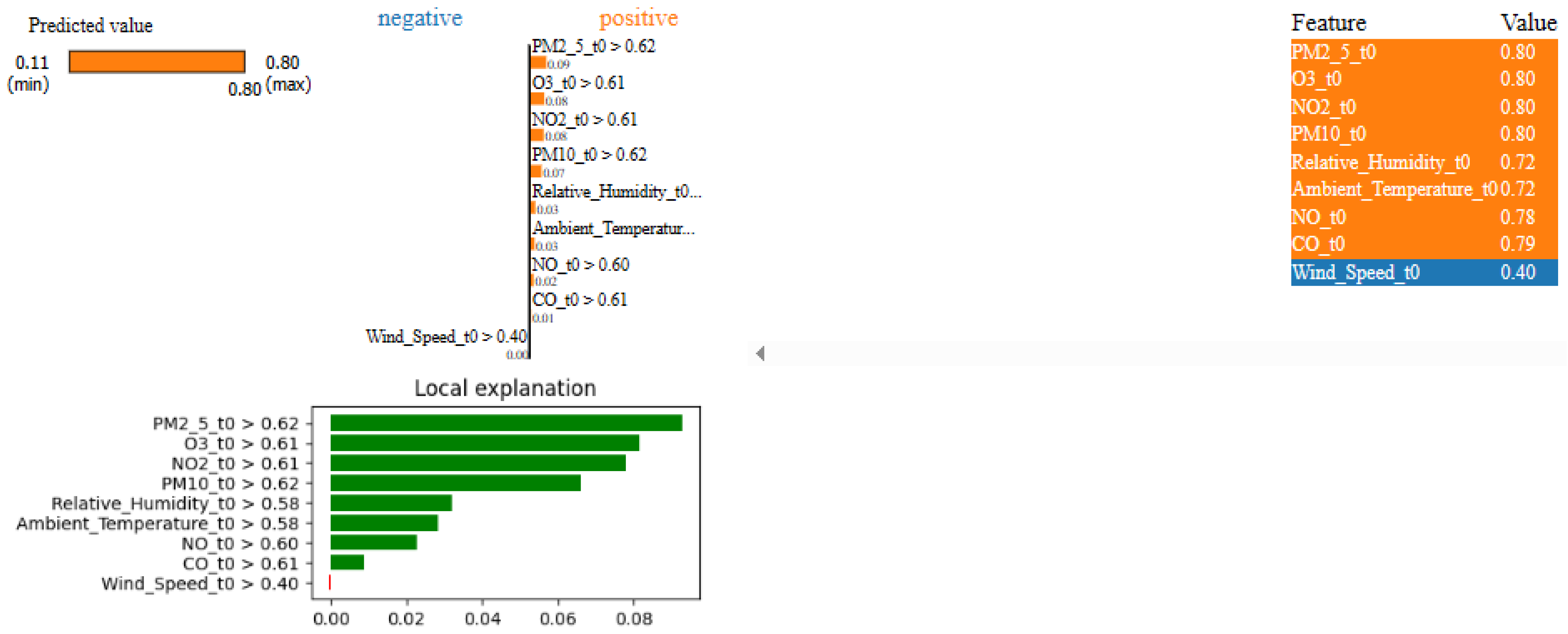
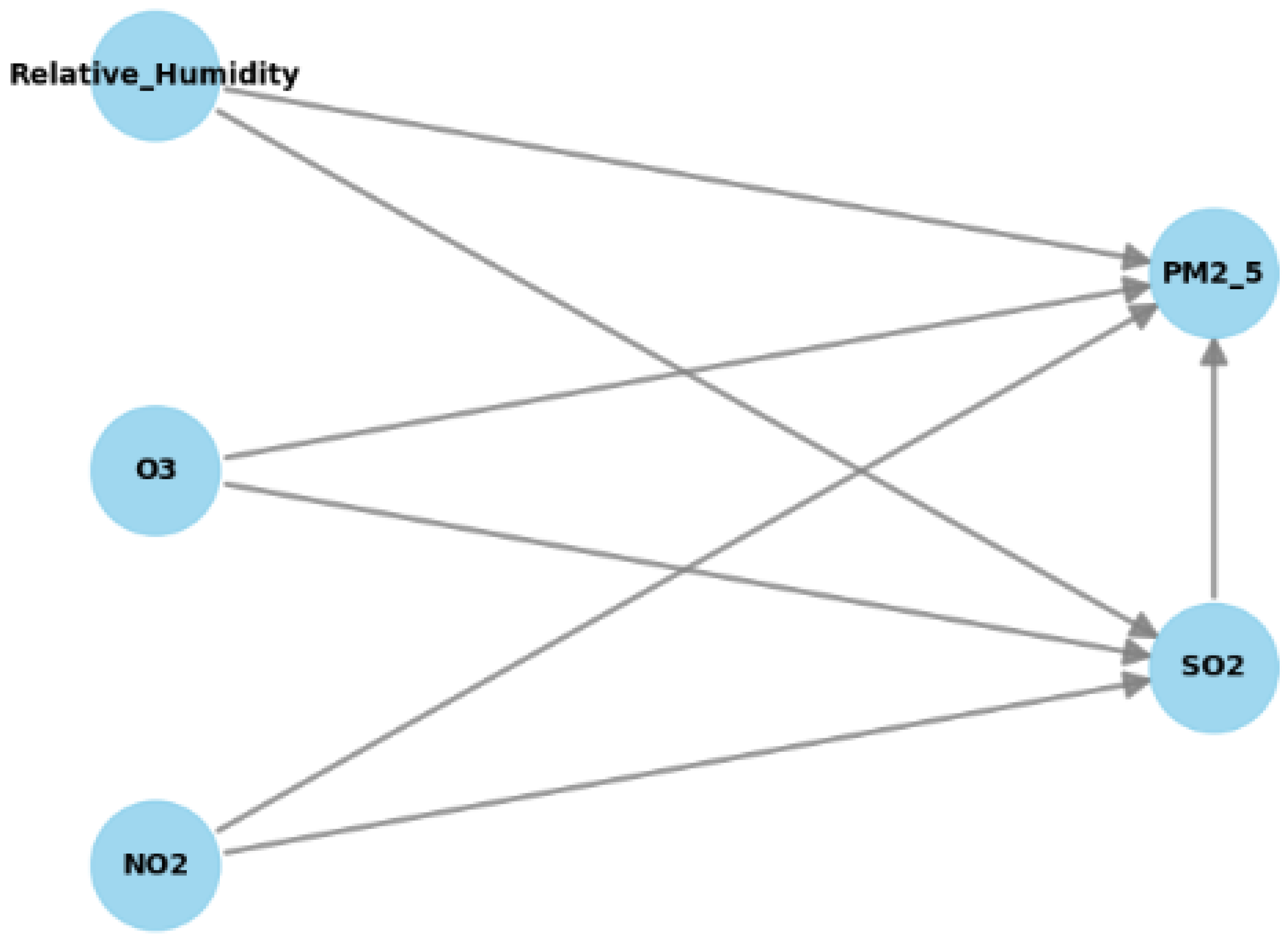

| Author | Hybrid Model | Pollutant | Problem Identified |
|---|---|---|---|
| Yuan, Mei [43] | Hybrid deep learning model (simple-RNN, LSTM, GRU, and TCN) | PM2.5 | How to extract features effectively from a large amount of relevant monitoring data |
| Hong, Choi [30] | CMAQ model and RNN-LSTM | PM2.5 and O3 | Lack of measures to identify and minimize the effects of air pollution. |
| Faydi, Zrelli [44] | CNN for feature extraction and LSTM for temporal sequence prediction | PM2.5 | To improve performance in smart monitoring systems used for air pollution |
| Shi, Li [42] | TCN with biGRU | PM2.5 | The random guess in RNN neural networks leads to performance issues. |
| Guo, He [45] | Hybrid CNN-LSTM | Meteorological | Reduces forecasting error for a one-month time step ahead |
| Lin, Lin [46] | LSTM with GAM and Bayesian network | CO, NO, NO2, NOx, O3, PM10, and PM2.5 Meteorological variable analysis procedure by considering both rainfall amount and patterns | Impact of traffic factors on air quality |
| Kaveh, Mesgari [47] | Geographic information systems (GISs), remote sensing (RS), and a hybrid LSTM architecture to predict Approach: orchard algorithm (OA) with LSTM to optimize air pollution forecasting | PM2.5 concentrations, meteorological data, topographical features, and satellite imagery | Gradient-based methods face limitations such as getting trapped in local minima, and high computational costs |
| Wang, Jwo [48] | RNNs with LSTM cells with LRP | Understanding and interpreting deep learning models in Global Navigation Satellite System (GNSS) | |
| Ganguli, Nakum [49] | RNN, LSTM, and GRU. ML models (ARIMA and SARIMA) for air quality prediction. RNN performs better | PM2.5 levels | Forecasting of air quality |
| Beriwal and Ayeelyan [50] | Federated learning that employed VGG-19 deep learning model with causal inference for model interpretability | PM2.5 and PM10 | To monitor and predict PM2.5 and PM10 from multiple locations, with impact analysis |
| Agbehadji and Obagbuwa [51] | BiLSTM with attention transformer mechanism with mode decomposition approach | Ozone prediction | Predict the nonlinear nature of O3 concentration in Johannesburg |
| Author | Research Purpose | Comparative Models | Approach | Pollutant | Evaluation Method | Accuracy Recorded |
|---|---|---|---|---|---|---|
| Zhou, Wang [59] | Air pollutant concentration prediction | RNN, GRU, LSTM, attention-LSTM and Kalman-LSTM | Kalman Filter, attention, and LSTM model | SO2, NO2, PM10, PM2.5, and CO | SE, RMSE, MAE, and better R-square | All have smaller values |
| Kataria and Puri [63] | Air quality index prediction | ANN, SVM, k-NN, CNN, LSTM, CNN-LSTM, ensemble model | A Kalman Filter removes unwanted noise from data collected via sensors Proposed model (CNN-LSTM-BOA), that is, CNN-LSTM-Bayesian optimization algorithm (BOA) model | CO and PM2.5 | MAE, RMSE, coefficient of determination (R2), and accuracy score | Over 97% accuracy |
| Yang, Cheng [64] | Impact of lidar on PM2.5 concentration and the wind fields | - | WRF-LETKF framework coupled with the CMAQ model | Lidar-retrieved PM2.5 | - | - |
| Lee, Yu [65] | An air quality prediction system was developed for the main air quality criteria species in South Korea | DA RUN was compared with those of the CMAQ simulations | Data assimilation (DA) of optimal interpolation (OI) with Kalman Filter was used in this study | PM10, PM2.5, CO, O3, and SO2 | Index of agreement | |
| Kong, Tang [66]; Kong, Tang [67]; Kong, Tang [68] | The uncertainties in predictive systems | - | Ensemble Kalman Filter and the Nested Air Quality Prediction Modeling System | NH3 emissions with large uncertainty | - | - |
| Song, Huang [61] | Prediction of time-series data with long-term and short-term characteristics | LSTM | LSTM and Kalman Filtering | CO, NO2, C6H6 | RMSE and R-square | The LSTM-Kalman model is better than the LSTM |
| Author | Research Focus | Approach |
|---|---|---|
| Kiran, Kumar [83] | Enhancing the measurement accuracy of thermal gradients in additive manufacturing | Explainable artificial intelligence (xAI) with LSTM networks. The framework includes LRP and SHAP. |
| Ndao, Youness [84] | Impact of data preprocessing and model complexity | LSTM predicts the remaining useful life (RUL). Explainable artificial intelligence (xAI) is used to understand the relationship between the input data and the predicted RUL. Three XAI post hoc local agnostic methods (LIME), SHAP, and Learning to eXplain (L2X) in the context of the RUL prediction. |
| Sunu Fathima and Kovoor [85] | The availability of a large amount of diverse weather data is a challenge for traditional models | Short-term temperature based on a Stacked LSTM. Explainable AI using SHapley Additive exPlanations (SHAP) to determine the influence of different features on the predicted values. |
| Metric | Formula | Explanation of Variables |
|---|---|---|
| MSE | is the predicted value from the model, and is the actual value of the target variable | |
| RMSE | ||
| R2 | is the mean of the actual target value, and N represents the number of data points |
| Model | Parameter Value |
|---|---|
| LSTM | Hidden units = 50, Batch size = 32 |
| Dense | 1 |
| Optimizer | “adam” |
| Epoch | 100 |
| Activation function | “relu” |
| AKF process noise | 0.01 |
| AKF measurement noise | 0.1 |
| Initial error covariance | 1 |
| Time step | 1–5, 10, 20, 30 |
| Features | Value |
| Relative_humidity_t0 | 0.000177438 |
| NO_t0 | 0.000103743 |
| CO_t0 | 7.01776 × 10−5 |
| NO2_t0 | 4.52497 × 10−5 |
| Ambient_Temperature_t0 | 4.25577 × 10−5 |
| O3_t0 | 2.50957 × 10−5 |
| PM2.5_t0 | 1.57543 × 10−5 |
| PM10_t0 | 1.44274 × 10−5 |
| Wind_speed_t0 | 0 |
| Feature# | Feature | Weight |
|---|---|---|
| 0 | PM2.5_t0 > 0.62 | 0.0926935 |
| 1 | O3_t0 > 0.61 | 0.0816015 |
| 2 | NO2_t0 > 0.61 | 0.0779279 |
| 3 | PM10_t0 > 0.62 | 0.0660164 |
| 4 | Relative_humidity_t0 > 0.58 | 0.0318761 |
| 5 | Ambient_Temperature_t0 > 0.58 | 0.0281854 |
| 6 | NO_t0 > 0.60 | 0.0225153 |
| 7 | CO_t0 > 0.61 | 0.00873191 |
| 8 | Wind_speed_t0 > 0.40 | −0.00055597 |
| Loss Function | Value |
|---|---|
| MSE | 0.6052 |
| RMSE | MSE | R2 | ||||||||||
|---|---|---|---|---|---|---|---|---|---|---|---|---|
| M-Day Time Step | AKF_LSTM_xAI | LSTM | LSTM_MLP | GRU | AKF_LSTM_xAI | LSTM | LSTM_MLP | GRU | AKF_LSTM_xAI | LSTM | LSTM_MLP | GRU |
| 1 | 0.382 | 2.122 | 3.602 | 2.309 | 0.146 | 4.504 | 12.972 | 5.332 | 0.991 | 0.786 | 0.385 | 0.747 |
| 2 | 0.805 | 2.249 | 3.064 | 2.837 | 0.648 | 5.061 | 9.386 | 8.054 | 0.960 | 0.760 | 0.554 | 0.618 |
| 3 | 0.828 | 2.262 | 4.608 | 3.086 | 0.685 | 5.114 | 21.239 | 9.522 | 0.957 | 0.757 | −0.007 | 0.548 |
| 4 | 0.755 | 2.323 | 2.715 | 2.762 | 0.570 | 5.396 | 7.3712 | 7.627 | 0.965 | 0.744 | 0.650 | 0.638 |
| 5 | 1.015 | 2.307 | 2.423 | 2.916 | 1.030 | 5.323 | 5.872 | 8.504 | 0.936 | 0.748 | 0.721 | 0.597 |
| 10 | 1.152 | 2.526 | 3.745 | 2.540 | 1.326 | 6.378 | 14.053 | 6.453 | 0.918 | 0.696 | 0.332 | 0.693 |
| 20 | 1.395 | 2.434 | 3.274 | 2.124 | 1.946 | 5.927 | 10.718 | 4.511 | 0.879 | 0.717 | 0.489 | 0.785 |
| 30 | 1.145 | 2.333 | 2.228 | 2.576 | 2.094 | 5.446 | 5.0105 | 6.634 | 0.870 | 0.739 | 0.760 | 0.682 |
| Summary | Value |
|---|---|
| Estimated effect | 2.94082 |
| New effect | 2.98081 |
| p-value | 0.98 |
| Summary of Effects | Column 1 | Column 2 |
|---|---|---|
| Estimated effect | 0.25432 | 0.110716 |
| New effect | 0.25435 | 0.110714 |
| p-value | 0.88 | 0.90 |
Disclaimer/Publisher’s Note: The statements, opinions and data contained in all publications are solely those of the individual author(s) and contributor(s) and not of MDPI and/or the editor(s). MDPI and/or the editor(s) disclaim responsibility for any injury to people or property resulting from any ideas, methods, instructions or products referred to in the content. |
© 2025 by the authors. Licensee MDPI, Basel, Switzerland. This article is an open access article distributed under the terms and conditions of the Creative Commons Attribution (CC BY) license (https://creativecommons.org/licenses/by/4.0/).
Share and Cite
Agbehadji, I.E.; Obagbuwa, I.C. Integration of Explainable Artificial Intelligence into Hybrid Long Short-Term Memory and Adaptive Kalman Filter for Sulfur Dioxide (SO2) Prediction in Kimberley, South Africa. Atmosphere 2025, 16, 523. https://doi.org/10.3390/atmos16050523
Agbehadji IE, Obagbuwa IC. Integration of Explainable Artificial Intelligence into Hybrid Long Short-Term Memory and Adaptive Kalman Filter for Sulfur Dioxide (SO2) Prediction in Kimberley, South Africa. Atmosphere. 2025; 16(5):523. https://doi.org/10.3390/atmos16050523
Chicago/Turabian StyleAgbehadji, Israel Edem, and Ibidun Christiana Obagbuwa. 2025. "Integration of Explainable Artificial Intelligence into Hybrid Long Short-Term Memory and Adaptive Kalman Filter for Sulfur Dioxide (SO2) Prediction in Kimberley, South Africa" Atmosphere 16, no. 5: 523. https://doi.org/10.3390/atmos16050523
APA StyleAgbehadji, I. E., & Obagbuwa, I. C. (2025). Integration of Explainable Artificial Intelligence into Hybrid Long Short-Term Memory and Adaptive Kalman Filter for Sulfur Dioxide (SO2) Prediction in Kimberley, South Africa. Atmosphere, 16(5), 523. https://doi.org/10.3390/atmos16050523








